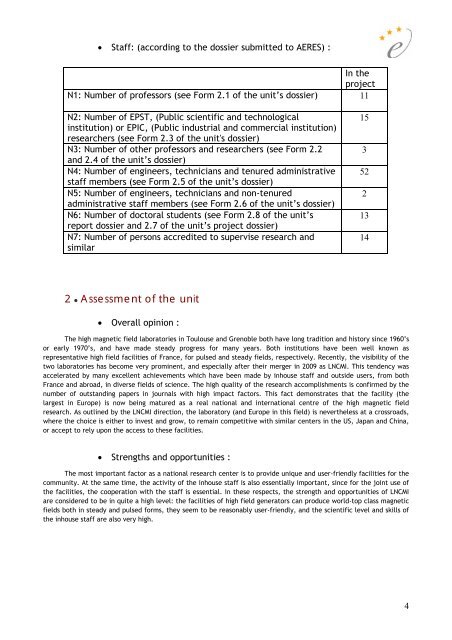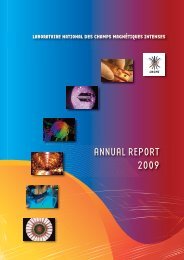Laboratoire National des Champs Magnétiques Pulsés CNRS – INSA
Laboratoire National des Champs Magnétiques Pulsés CNRS – INSA
Laboratoire National des Champs Magnétiques Pulsés CNRS – INSA
You also want an ePaper? Increase the reach of your titles
YUMPU automatically turns print PDFs into web optimized ePapers that Google loves.
� Staff: (according to the dossier submitted to AERES) :<br />
In the<br />
project<br />
N1: Number of professors (see Form 2.1 of the unit’s dossier) 11<br />
N2: Number of EPST, (Public scientific and technological<br />
institution) or EPIC, (Public industrial and commercial institution)<br />
researchers (see Form 2.3 of the unit's dossier)<br />
N3: Number of other professors and researchers (see Form 2.2<br />
and 2.4 of the unit’s dossier)<br />
N4: Number of engineers, technicians and tenured administrative<br />
staff members (see Form 2.5 of the unit’s dossier)<br />
N5: Number of engineers, technicians and non-tenured<br />
administrative staff members (see Form 2.6 of the unit’s dossier)<br />
N6: Number of doctoral students (see Form 2.8 of the unit’s<br />
report dossier and 2.7 of the unit’s project dossier)<br />
N7: Number of persons accredited to supervise research and<br />
similar<br />
2 � Assessment of the unit<br />
� Overall opinion :<br />
The high magnetic field laboratories in Toulouse and Grenoble both have long tradition and history since 1960’s<br />
or early 1970’s, and have made steady progress for many years. Both institutions have been well known as<br />
representative high field facilities of France, for pulsed and steady fields, respectively. Recently, the visibility of the<br />
two laboratories has become very prominent, and especially after their merger in 2009 as LNCMI. This tendency was<br />
accelerated by many excellent achievements which have been made by inhouse staff and outside users, from both<br />
France and abroad, in diverse fields of science. The high quality of the research accomplishments is confirmed by the<br />
number of outstanding papers in journals with high impact factors. This fact demonstrates that the facility (the<br />
largest in Europe) is now being matured as a real national and international centre of the high magnetic field<br />
research. As outlined by the LNCMI direction, the laboratory (and Europe in this field) is nevertheless at a crossroads,<br />
where the choice is either to invest and grow, to remain competitive with similar centers in the US, Japan and China,<br />
or accept to rely upon the access to these facilities.<br />
� Strengths and opportunities :<br />
The most important factor as a national research center is to provide unique and user-friendly facilities for the<br />
community. At the same time, the activity of the inhouse staff is also essentially important, since for the joint use of<br />
the facilities, the cooperation with the staff is essential. In these respects, the strength and opportunities of LNCMI<br />
are considered to be in quite a high level: the facilities of high field generators can produce world-top class magnetic<br />
fields both in steady and pulsed forms, they seem to be reasonably user-friendly, and the scientific level and skills of<br />
the inhouse staff are also very high.<br />
15<br />
3<br />
52<br />
2<br />
13<br />
14<br />
4







